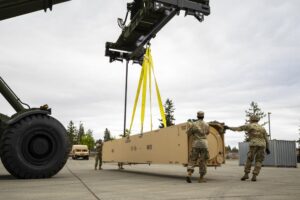The Army is preparing to deliver the first live rounds for its initial hypersonic weapon battery in about six months, according to the program’s lead official.
Lt. Gen. Neil Thurgood, director of the Army’s Rapid Capabilities and Critical Technologies Office, said the delivery plan keeps the service on track to meet its goal of fielding the first Long Range Hypersonic Weapon (LRHW) operational capability by the end of fiscal year 2023.

“We start delivering those live rounds, I’ll just roughly say, in about six months, as we finish the design of the round itself. Is there risk associated with that? Absolutely. Can we afford to wait? Absolutely not,” Thurgood told attendees on Wednesday at the Space and Missile Defense Symposium in Huntsville, Alabama.
Early last fall, the Army announced it had completed fielding of the ground equipment for its first prototype hypersonic weapon battery, minus the live rounds, to the soldiers from the I Corps’ 5th Battalion, 3rd Field Artillery Regiment, 17th Field Artillery Brigade at Joint Base Lewis-McChord in Washington (Defense Daily, Oct. 7 2021).
Thurgood noted the unit set to operate the first battery of the hypersonic weapon, now also known as Dark Eagle, recently ran through a simulated live fire event.
“They did an entire kill chain, from the U.S Indo-Pacific Command down to the theater fires center all the way down to the unit. And then they conducted a simulated live fire event. We did that eight times to make sure that the unit is ready,” Thurgood said. “Traditionally in materiel programs…you produce everything, you get everything in place and then you give it to the unit. We chose a different approach. Get the unit ready, train the unit to use it and then, eventually, give them live rounds.”
Deliveries of the live rounds to provide the unit “a basic load” of missiles will be completed by the end of FY ‘23 to meet the service’s target date to field the first LRHW operational capability, Thurgood has said previously.
The Army’s hypersonic weapon development is a joint effort with the Navy designing the Common Hypersonic Glide Body (C-HGB) and the Army overseeing production.
In 2019, the Army chose Lockheed Martin [LMT] to serve as the weapon systems integrator for the LRHW, which will be fired from a truck, while Dynetics [LDOS] is tasked with producing the C-HGB (Defense Daily, Aug. 30, 2019).
Eric Scherff, Lockheed Martin’s vice president of hypersonic strike programs, has previously said the company’s objective is to produce 24 hypersonic all-up missile rounds per year (Defense Daily, Oct. 13 2021).
Each battery of the Army’s offensive hypersonic weapon will consist of four road-mobile, C-17 transportable launchers that can each carry two rounds, a battery operations center and a group of modified trucks and trailers.
Thurgood said Wednesday a second battery of Dark Eagle is expected to be fielded in FY ‘25, with the Army’s Program Executive Officer Missiles and Space set to handle future deliveries once in control of the program.